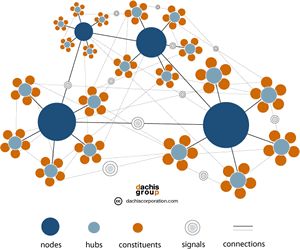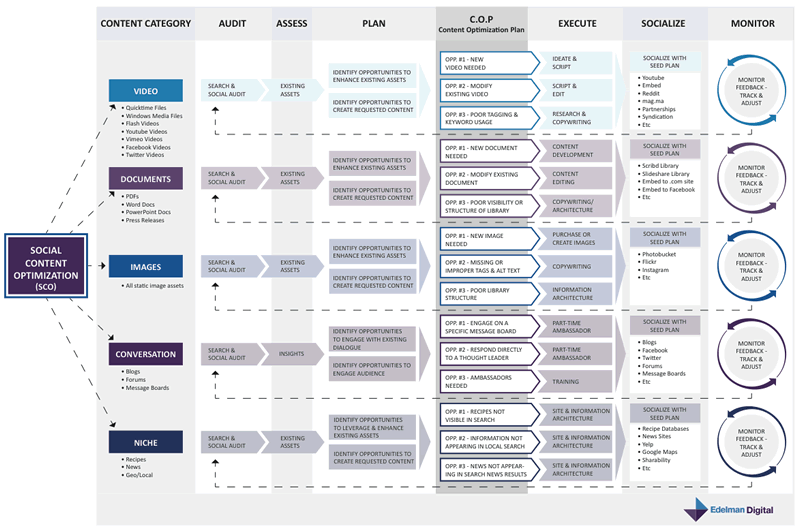
Social content marketing is the area where content marketing and social media/business meet. With an increasingly connected consumer and social B2B buying journey, the attention for social content marketing tactics and strategies is growing. However, the term isn’t only about social sharing or optimizing content for social channels. It’s also about connecting social business, collaboration and newsroom techniques and principles to content marketing.
In many social content marketing models, blogs (the first real ‘social platforms’) are the content hubs and the social channels and media are the spokes used to spread content across connected audiences. However, a solid content strategy is more complex than that and also includes websites and even offline activities. It doesn’t put the medium (such as a blog) but the customer, buying persona or audience at the center, in combination with the marketing goals.
Nevertheless, a social content strategy (from plan to execution) makes sense as social media are crucial in most content marketing efforts and vice versa. It even makes sense to look at different social content sub-strategies, adapted to the individual channels. Too often businesses use all social channels the same way: sharing pieces of content in a fast and non-optimized way.
Social content optimization and strategy: main components
By using social content optimization, the impact of content shared via different social channels and even across devices and depending on the usage context and inherent features of each social channel, depending on your target audiences. Targeting, segmentation and an optimized social content approach usually beat the one-size-fits-all blast method many businesses really use to get their content shared. Optimizing content and a content strategy for, let’s say, LinkedIn, can lead to far better results by taking the behavior of LinkedIn users and specifics of the channel and how content is used in them, into account.
Finally, social content marketing ties the social collaboration and infrastructure dimensions to the content workflows and involvement of the whole ecosystem (employees, audiences, etc). and often involves using social newsrooms and/or command centers to create a loop between content creation and social input/interaction.
Typically a social content strategy:
- Takes the needs and behavior of target audiences and their audiences into account.
- Analyzes how target audiences and personas use different social channels to find information during each stage of their journey.
- Looks at how user-generated content and social content can be integrated (for instance from social curation platforms such as Scoop.it, Pinterest or even simply Twitter embeds) to provide more context and/or value.
- Has an integrated social approach whereby the different social channels strengthen eachother, while avoiding marketing fatigue or message overkill.
- Is integrated with the overall content marketing strategy.
- Includes a calendar per social channel and contact moment, integrated with the editorial calendar, or on top of it, that maps the content, target audiences, behavior (time to send) and KPIs.
- Integrates with search that is increasingly becoming defined by social signals.
- Is connected with a marketing automation platform and social media platforms so potentially interesting contacts can be followed up as social media themselves and certainly in a B2B context, rarely return leads.
- Goes far beyond the simple sharing of content: monitoring, listening and understanding what target audiences are talking about or what they share should lead to production of content responding to expressed needs.
- Looks at sharing behavior and triggers, as well as the ideal form and format per channel, depending on the behavior of all personas or audiences.
- Focuses on how shareworthy the content is per channel and target audience.
- Engages and drives to action by addressing issues, responding to questions and speaking to and through audiences.
- Looks at the contextual placement of sharing buttons and tools in channels and media where sharing is important for your purposes.
- Includes an approach regarding social interaction, comments, etc.
- Feeds back social signals to trigger next actions and/or spur more social interaction.
- Connects social collaboration and business principles with the content strategy.
- Connects the dots between organization, social technologies, content and the social Voice Of the Customer, UGC and social media evolutions.
- Ties social newsroom and social command centers if these are present/relevant.
These are just a few of the main social content marketing tasks to take into account.
More tips and suggestions:
- Social content optimization, whereby the social channels are looked upon as media themselves and the actual sharing of content seen as the creation of content within a broader context requires little effort that can result in high impact. A tweet, for instance, can – and should – be approached as a contextual piece of content and social object as such.
- Measurement and improvement using a combination of social media platforms, analytics, CRM and/or marketing automation allows you to test the impact of social content across the journey of your social connections. Furthermore, it’s important to see and monitor how your social content travels and how the social interactions of your target audiences can steer and improve your content marketing and even overall content marketing strategy.

Often used social channels and tools in a social content context are:
- Owned media and earned media including blogs.
- Usual suspects such as Slideshare, Twitter, YouTube, Google+, LinkedIn, …
- Social curation platforms.
- Pinterest and consumer-oriented curation/bookmarking tools.
- Social collaboration tools.
- Social- and collaboration enabled intranets, extranets and information management solutions.
- Etc.
The list is much longer in reality but it’s best to focus on those channels your audiences use first, in combination with experiments on channels with low risk and high potential ROI.

